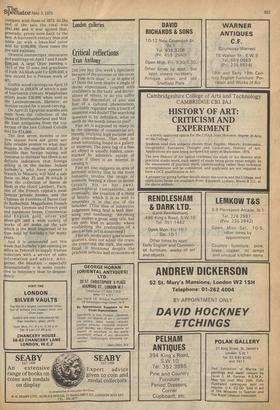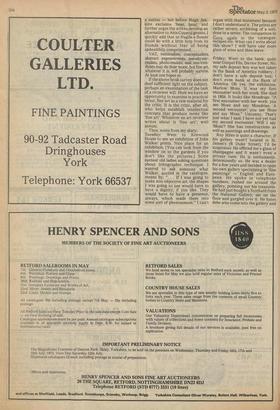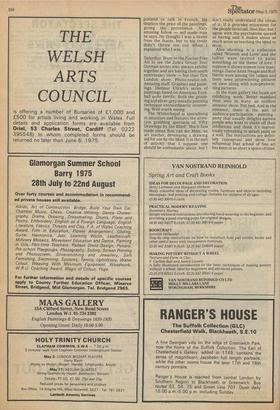London galleries
Critical reflections
Evan Anthony
Did you buy this week's Spectator because of the promise on the cover — 'Fine Arts issue' — or in spite of it? Does the term inspire a tingle of divine expectation, coupled with confidence in the taste and declarations of others, or do you suffer from the discomfort of awe and fear of a cultural phenomenon, inevitably regarded with a touch of suspicion and doubt? The searching question is, by definition, what on earth do the words mean to you?
Fine art is supposed by many to, be the opposite of commercial art, thereby Implying high purpose and deep commitment. That used to mean something found in a gallery or museum. The price tag of a fine art object is usually hidden, unremarked by admirers, except of course if there is an interest in owning it.
Fine art also suggests an area of personal activity that to the more romantic invites the image of someone beating a chest or breast (usually his or her own), philosophical ruminations, and eventually, the creation of a thing of beauty, which it is as well to remember is in the eye of the beholder. (This idea of subjective judgement being final is both liberating and confusing. 'Anything goes' makes a great song title, but can only lead to anarchy where establishing the credentials of a piece of fine art is concerned.)
Fine art, as the story goes in some quarters, does not admit the crass, the contrived, the slick, the superficial. It blossoms despite the practical policies and economies of a nation — but before Hugh Jenkins exclaims 'hear, hear' and further urges the arts to develop an alternative to Arts Council grants, I quickly add that so fragile a flower could do with a little help from its friends without fear of being unhealthily compromised.
VAT, minimalists, conceptualists, abstract expressionists, pseudo-sur realists, photo-realists, and neo-trendyists may do their worst, but fine art, whatever it is, will probably survive. At least one hopes so.
If the above brisk survey does not shed sufficient light on the subject, perhaps an examination of the task of a reviewer will. Here we have an opportunity to examine in practical terms, fine art as a raw material for
the critic. It is the critic, after all, who helps establish intellectual
concepts that produce terms like 'fine art'. Whatever an art reviewer writes about is 'fine art'; well almost.
Thus, notes from my diary: Tuesday; Went to Kenwood House to see an exhibition of John Walker prints. Nice place for an exhibition. (You can look from the window on to the gardens if you don't like the pictures,) Some earnest old ladies asking questions about lithographic technique. I wanted to ask someone what Walker, quoted in the catalogue, means by: ". . . If! was going to make non-objective art, the shapes I was going to use would have to have a dignity, if you like. They would have to have a presence, always, which made them into some sort of phenomenon." I can't
argue with that statement because I don't understand it. The prints are rather severe, scribbling of a sort, done in a series. The comparison to 6oya, again in the catalogue, escapes me. What can I write about this show? I will have one more glass of wine and then leave.
Friday; Went to the bank, quite near Gimpel Fils, Davies Street. No, my safe deposit box was not taken in the Bank of America robbery, I don't have a safe deposit box; I don't even bank at the Bank of America. Oh yes, the exhibition. Marlow Moss. It was my first encounter with her work. She died in 1958. It looks like Mondrian. "A first encounter with her work: you see Moss and say Mondrian. A second encounter; you see Moss and say Moss." Uncanny. That's just what I said. I have not yet had my second encounter. Will I say 'Moss'? She has constructions as well as paintings and drawings.
Roy Miles is quite a character. If his gallery wasn't located in St. James's (6 Duke Street), I'd be suspicious. He offered me a glass of champagne and it wasn't even a private view. He is enthusiastic, determinedly so. He was a dealer for a few years and decided to open his own gallery specialising in 'fine paintings' — English and European. He spoke in telephone numbers, rushed me around the gallery, pointing out his treasures. He had just bought a Stothard from the National Gallery, sat on the floor and gurgled over it. He hates debs who come into the gallery and pretend to talk in French. He displays the price of the paintings, giving the provenance. Very amusing fellow — self-made man he says. He thought I was a dealer from the States, but to his credit didn't throw me out when I explained who I was.
Saturday: Went to the Fischer Fine Art to see the Zebra Group: four German artists who always exhibit together and are having their tenth anniversary show — but their first London show. Photo-realist-ish. Amusing stuff. Graphics and paintings. Dietmar Ullrich's series of paintings based on American Football quite terrific. Both the grouping and silver-grey metallic painting technique extraordinarily interesting. Well worth seeing.
The Whitechapel is specialising in amateurs and features the attention grabbing spectacle of 'Fifty Drawings by the Blind'. Much fuss made about Ron van der Meer, an art teacher, developing a drawing aid for use by the blind. It is the sort of activity that I suppose one should be enthusiastic about, but I don't really understand the virtue of it. If it provides enjoyment for the people involved, then fine, but I agree with the psychiatrist quoted as having said it makes about as much sense as teaching the blind to drive.
Also showing is a collection called 'Women and Love' and the ladies were invited to paint something on the theme of love. I suppose it shows women love many things. Dame Anna Neagle and Rolf Harris were among the judges and there were prizewinning pictures on view along with non-prizewinning pictures.
In the main gallery the locals are exhibiting work. Better standard than seen in many an outdoor amateur show. Not bad. And in the entrance, there is the sort of audience-participation painting party that usually delights earnest people who want to shake off their inhibitions and think it's marvellously refreshing to splash paint on a wall. The instructions are definitely conceptual and show how influential that school of fine art has been in so short a space of time.




































 Previous page
Previous page